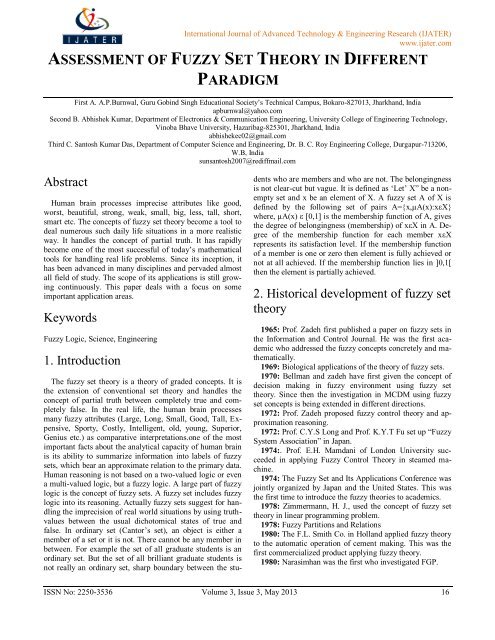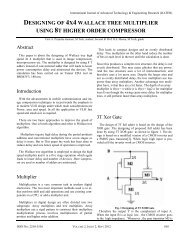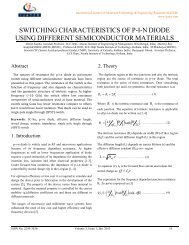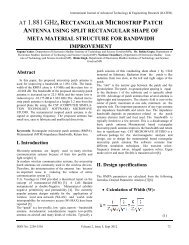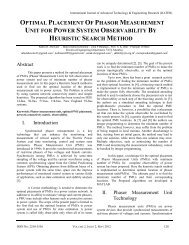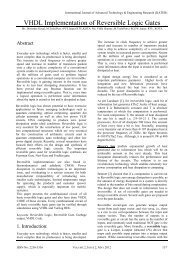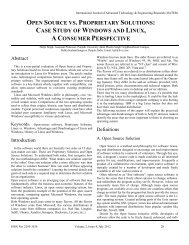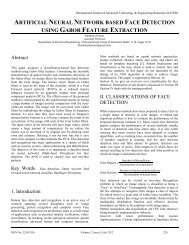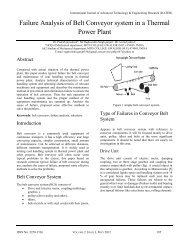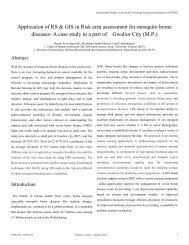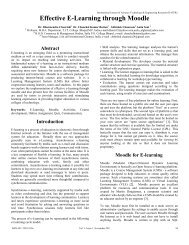assessment of fuzzy set theory in different paradigm - ijater
assessment of fuzzy set theory in different paradigm - ijater
assessment of fuzzy set theory in different paradigm - ijater
You also want an ePaper? Increase the reach of your titles
YUMPU automatically turns print PDFs into web optimized ePapers that Google loves.
International Journal <strong>of</strong> Advanced Technology & Eng<strong>in</strong>eer<strong>in</strong>g Research (IJATER)www.<strong>ijater</strong>.comASSESSMENT OF FUZZY SET THEORY IN DIFFERENTPARADIGMFirst A. A.P.Burnwal, Guru Gob<strong>in</strong>d S<strong>in</strong>gh Educational Society‟s Technical Campus, Bokaro-827013, Jharkhand, Indiaapburnwal@yahoo.comSecond B. Abhishek Kumar, Department <strong>of</strong> Electronics & Communication Eng<strong>in</strong>eer<strong>in</strong>g, University College <strong>of</strong> Eng<strong>in</strong>eer<strong>in</strong>g Technology,V<strong>in</strong>oba Bhave University, Hazaribag-825301, Jharkhand, Indiaabhishekec02@gmail.comThird C. Santosh Kumar Das, Department <strong>of</strong> Computer Science and Eng<strong>in</strong>eer<strong>in</strong>g, Dr. B. C. Roy Eng<strong>in</strong>eer<strong>in</strong>g College, Durgapur-713206,W.B, Indiasunsantosh2007@rediffmail.comAbstractHuman bra<strong>in</strong> processes imprecise attributes like good,worst, beautiful, strong, weak, small, big, less, tall, short,smart etc. The concepts <strong>of</strong> <strong>fuzzy</strong> <strong>set</strong> <strong>theory</strong> become a tool todeal numerous such daily life situations <strong>in</strong> a more realisticway. It handles the concept <strong>of</strong> partial truth. It has rapidlybecome one <strong>of</strong> the most successful <strong>of</strong> today‟s mathematicaltools for handl<strong>in</strong>g real life problems. S<strong>in</strong>ce its <strong>in</strong>ception, ithas been advanced <strong>in</strong> many discipl<strong>in</strong>es and pervaded almostall field <strong>of</strong> study. The scope <strong>of</strong> its applications is still grow<strong>in</strong>gcont<strong>in</strong>uously. This paper deals with a focus on someimportant application areas.KeywordsFuzzy Logic, Science, Eng<strong>in</strong>eer<strong>in</strong>g1. IntroductionThe <strong>fuzzy</strong> <strong>set</strong> <strong>theory</strong> is a <strong>theory</strong> <strong>of</strong> graded concepts. It isthe extension <strong>of</strong> conventional <strong>set</strong> <strong>theory</strong> and handles theconcept <strong>of</strong> partial truth between completely true and completelyfalse. In the real life, the human bra<strong>in</strong> processesmany <strong>fuzzy</strong> attributes (Large, Long, Small, Good, Tall, Expensive,Sporty, Costly, Intelligent, old, young, Superior,Genius etc.) as comparative <strong>in</strong>terpretations.one <strong>of</strong> the mostimportant facts about the analytical capacity <strong>of</strong> human bra<strong>in</strong>is its ability to summarize <strong>in</strong>formation <strong>in</strong>to labels <strong>of</strong> <strong>fuzzy</strong><strong>set</strong>s, which bear an approximate relation to the primary data.Human reason<strong>in</strong>g is not based on a two-valued logic or evena multi-valued logic, but a <strong>fuzzy</strong> logic. A large part <strong>of</strong> <strong>fuzzy</strong>logic is the concept <strong>of</strong> <strong>fuzzy</strong> <strong>set</strong>s. A <strong>fuzzy</strong> <strong>set</strong> <strong>in</strong>cludes <strong>fuzzy</strong>logic <strong>in</strong>to its reason<strong>in</strong>g. Actually <strong>fuzzy</strong> <strong>set</strong>s suggest for handl<strong>in</strong>gthe imprecision <strong>of</strong> real world situations by us<strong>in</strong>g truthvaluesbetween the usual dichotomical states <strong>of</strong> true andfalse. In ord<strong>in</strong>ary <strong>set</strong> (Cantor‟s <strong>set</strong>), an object is either amember <strong>of</strong> a <strong>set</strong> or it is not. There cannot be any member <strong>in</strong>between. For example the <strong>set</strong> <strong>of</strong> all graduate students is anord<strong>in</strong>ary <strong>set</strong>. But the <strong>set</strong> <strong>of</strong> all brilliant graduate students isnot really an ord<strong>in</strong>ary <strong>set</strong>, sharp boundary between the studentswho are members and who are not. The belong<strong>in</strong>gnessis not clear-cut but vague. It is def<strong>in</strong>ed as „Let‟ X” be a nonempty<strong>set</strong> and x be an element <strong>of</strong> X. A <strong>fuzzy</strong> <strong>set</strong> A <strong>of</strong> X isdef<strong>in</strong>ed by the follow<strong>in</strong>g <strong>set</strong> <strong>of</strong> pairs A={x,µA(x):xεX}where, µA(x) ε [0,1] is the membership function <strong>of</strong> A, givesthe degree <strong>of</strong> belong<strong>in</strong>gness (membership) <strong>of</strong> xεX <strong>in</strong> A. Degree<strong>of</strong> the membership function for each member xεXrepresents its satisfaction level. If the membership function<strong>of</strong> a member is one or zero then element is fully achieved ornot at all achieved. If the membership function lies <strong>in</strong> ]0,1[then the element is partially achieved.2. Historical development <strong>of</strong> <strong>fuzzy</strong> <strong>set</strong><strong>theory</strong>1965: Pr<strong>of</strong>. Zadeh first published a paper on <strong>fuzzy</strong> <strong>set</strong>s <strong>in</strong>the Information and Control Journal. He was the first academicwho addressed the <strong>fuzzy</strong> concepts concretely and mathematically.1969: Biological applications <strong>of</strong> the <strong>theory</strong> <strong>of</strong> <strong>fuzzy</strong> <strong>set</strong>s.1970: Bellman and zadeh have first given the concept <strong>of</strong>decision mak<strong>in</strong>g <strong>in</strong> <strong>fuzzy</strong> environment us<strong>in</strong>g <strong>fuzzy</strong> <strong>set</strong><strong>theory</strong>. S<strong>in</strong>ce then the <strong>in</strong>vestigation <strong>in</strong> MCDM us<strong>in</strong>g <strong>fuzzy</strong><strong>set</strong> concepts is be<strong>in</strong>g extended <strong>in</strong> <strong>different</strong> directions.1972: Pr<strong>of</strong>. Zadeh proposed <strong>fuzzy</strong> control <strong>theory</strong> and approximationreason<strong>in</strong>g.1972: Pr<strong>of</strong>. C.Y.S Long and Pr<strong>of</strong>. K.Y.T Fu <strong>set</strong> up “FuzzySystem Association” <strong>in</strong> Japan.1974:. Pr<strong>of</strong>. E.H. Mamdani <strong>of</strong> London University succeeded<strong>in</strong> apply<strong>in</strong>g Fuzzy Control Theory <strong>in</strong> steamed mach<strong>in</strong>e.1974: The Fuzzy Set and Its Applications Conference wasjo<strong>in</strong>tly organized by Japan and the United States. This wasthe first time to <strong>in</strong>troduce the <strong>fuzzy</strong> theories to academics.1978: Zimmermann, H. J., used the concept <strong>of</strong> <strong>fuzzy</strong> <strong>set</strong><strong>theory</strong> <strong>in</strong> l<strong>in</strong>ear programm<strong>in</strong>g problem.1978: Fuzzy Partitions and Relations1980: The F.L. Smith Co. <strong>in</strong> Holland applied <strong>fuzzy</strong> <strong>theory</strong>to the automatic operation <strong>of</strong> cement mak<strong>in</strong>g. This was thefirst commercialized product apply<strong>in</strong>g <strong>fuzzy</strong> <strong>theory</strong>.1980: Narasimhan was the first who <strong>in</strong>vestigated FGP.ISSN No: 2250-3536 Volume 3, Issue 3, May 2013 16
1981: Ch<strong>in</strong>a established “Ch<strong>in</strong>a Fuzzy Mathematics andSystem Association.” The members were ma<strong>in</strong>ly mathematicianswho were specialized <strong>in</strong> conduct<strong>in</strong>g research <strong>in</strong> the<strong>fuzzy</strong> mathematics theories. By do<strong>in</strong>g so, <strong>fuzzy</strong> <strong>theory</strong> wasstrengthened <strong>in</strong> the scope <strong>of</strong> mathematics.1981: Ch<strong>in</strong>a published “Journal <strong>of</strong> Fuzzy Mathematics,”the second journal on <strong>fuzzy</strong> <strong>theory</strong>. In 1987, it was renamedto “Fuzzy System and Mathematics.” S<strong>in</strong>ce then, Ch<strong>in</strong>a tooka lead<strong>in</strong>g role <strong>in</strong> <strong>fuzzy</strong> mathematics theories.1983: D. S<strong>in</strong>gh have used <strong>fuzzy</strong> <strong>set</strong> <strong>theory</strong> to solve l<strong>in</strong>earand/or non-l<strong>in</strong>ear vector maximum problems.1984: The International Fuzzy Systems Association was<strong>set</strong> up this organization dedicated to support, developmentand fundamental issues <strong>of</strong> <strong>fuzzy</strong> <strong>set</strong> <strong>theory</strong>. Pr<strong>of</strong>. H.J. Zimmermann<strong>of</strong> Technical University <strong>of</strong> Berl<strong>in</strong> was elected to bethe chairman.1984: Orlovsky has formulated MONLP problems with<strong>fuzzy</strong> parameters.1985: The first Fuzzy IFSA World Congress was held <strong>in</strong>Spa<strong>in</strong>. There were a total <strong>of</strong> 290 researchers from 29 countriesattend<strong>in</strong>g the congress. It is <strong>of</strong> <strong>in</strong>terest to note that theconference papers were ma<strong>in</strong>ly related to theoretical foundations,but not practical applications.1986:. Japan <strong>set</strong> up “Japan Society <strong>of</strong> Fuzzy Theory andSystem (SOFT)”1986:. Fuji electrical eng<strong>in</strong>eer<strong>in</strong>g, Fuji Facom and TokyoIndustry University had applied <strong>fuzzy</strong> control <strong>theory</strong> tomanage the import <strong>of</strong> clear water system and they had got avery good result.1987: The second Fuzzy IFSA World Congress was held<strong>in</strong> Tokyo. There were a total <strong>of</strong> 380 researchers from 25countries attend<strong>in</strong>g the congress. There were a total <strong>of</strong> 250conference papers and many <strong>of</strong> them were related to practicalapplications.1987: Japan first applied Fuzzy Control to successfullyaccomplish automatic driv<strong>in</strong>g systems.1988: The first Neural Networks and Fuzzy Logic AppliedTechnical Conference were held <strong>in</strong> NASA.1989: The third Fuzzy IFSA World Congress was held <strong>in</strong>Seattle, and there were numerous conference papers on practicalapplications.1989: The Laboratory for International Fuzzy Eng<strong>in</strong>eer<strong>in</strong>gResearch was <strong>set</strong> up, which was ma<strong>in</strong>ly composed <strong>of</strong> <strong>in</strong>dustrypractitioners, government <strong>of</strong>ficials, and academics.1989: The “Ch<strong>in</strong>a‟s Governmental Natural Science Fund<strong>in</strong>gCommittee” funded 1,350 thousand RMB dollars to <strong>set</strong>up 35 tertiary schools and research organizations so as to<strong>in</strong>vestigate a research project entitled „Fuzzy Message Managementand Mechanical Intelligence,‟ which was led byPr<strong>of</strong>essor P.Z. Wang.1989: The Ch<strong>in</strong>a Productivity Centre <strong>set</strong> up a FuzzyGroup to <strong>in</strong>troduce <strong>fuzzy</strong> techniques and advocate the <strong>fuzzy</strong>theories.1989: Sakawa and Yano have presented an <strong>in</strong>teractive<strong>fuzzy</strong> satisfic<strong>in</strong>g method for MONLP problems with <strong>fuzzy</strong>numbersInternational Journal <strong>of</strong> Advanced Technology & Eng<strong>in</strong>eer<strong>in</strong>g Research (IJATER)www.<strong>ijater</strong>.com1990: R.K. Verma have considered multi-objective geometricproblem <strong>in</strong> the <strong>fuzzy</strong> environment.1991: The fourth Fuzzy IFSA World Congress was held <strong>in</strong>Belgium.1993: An academic journal entitled “IEEE Transaction onFuzzy Systems” was first published.1993: The fifth Fuzzy IFSA World Congress was held <strong>in</strong>South Korea. The themes <strong>of</strong> conference papers <strong>in</strong>cludedcontrol system, image process<strong>in</strong>g, mach<strong>in</strong>e video, medicaldiagnosis, share prediction, synthetic <strong>assessment</strong>, managementtechnology, and system research.1993: The First Asia Fuzzy Symposium was held <strong>in</strong> S<strong>in</strong>gapore.1993: The first Fuzzy Theory and its Applications Conferencewas jo<strong>in</strong>tly organized by Ts<strong>in</strong>g Wah University andJiao Tong University.1994: The Republic <strong>of</strong> Ch<strong>in</strong>a Fuzzy Association was <strong>set</strong>up.1994: The second Fuzzy Theory and its Applications Conferencewas held <strong>in</strong> Taiwan, which was jo<strong>in</strong>tly organized byTaiwan University and Taiwan Industrial Technical University.1994: The sixth Fuzzy IFSA World Congress was held <strong>in</strong>the United States.1997: Generalized Modus Ponens1999: Application <strong>of</strong> the Fuzzy Logic <strong>in</strong> Traffic Controland Transportation Plann<strong>in</strong>g2001: Fuzzy goal programm<strong>in</strong>g model for design <strong>of</strong> multiobjective cellular manufactur<strong>in</strong>g system2003: Fuzzy Control for real Nuclear Reactor Operations2005: Use <strong>of</strong> Fuzzy for Dynamic Data M<strong>in</strong><strong>in</strong>g2007: Fuzzy Logic for Internet Application2011: Application <strong>of</strong> Fuzzy Logic <strong>in</strong> Rout<strong>in</strong>g <strong>in</strong> Ad-HocWireless Network2012: Use <strong>of</strong> Fuzzy Logic <strong>in</strong> Estimat<strong>in</strong>g Reliability <strong>of</strong>Component Based S<strong>of</strong>tware3. Application <strong>of</strong> <strong>fuzzy</strong> <strong>set</strong> <strong>theory</strong>Pr<strong>of</strong>. L. A. Zadeh (20) laid the foundation <strong>of</strong> <strong>fuzzy</strong> <strong>set</strong><strong>theory</strong>, which is the generalization <strong>of</strong> classical <strong>set</strong> <strong>theory</strong>.Due to this generalization, <strong>theory</strong> <strong>of</strong> <strong>fuzzy</strong> <strong>set</strong>s has a widerscope <strong>of</strong> applicability than that <strong>of</strong> an abstract <strong>set</strong> <strong>theory</strong> <strong>in</strong>solv<strong>in</strong>g problems, which <strong>in</strong>volves subjective evaluation tosome extent. In about four decades <strong>of</strong> its existence, it hasbeen used <strong>in</strong> many areas. Fuzzy logic works by turn<strong>in</strong>g thehard-edged world <strong>of</strong> b<strong>in</strong>ary logic <strong>in</strong>to more natural humanlike reason<strong>in</strong>g. Medic<strong>in</strong>e was one <strong>of</strong> the first fields <strong>in</strong> whichit was applied. After its formal <strong>in</strong>troduction, the use <strong>of</strong> <strong>fuzzy</strong>concepts was extended from the philosophy <strong>of</strong> medic<strong>in</strong>e tothe technology <strong>of</strong> medic<strong>in</strong>e. This medical application <strong>of</strong><strong>fuzzy</strong> <strong>set</strong>s, systems, and relations appeared shortly after developmentmedical expert systems [74], [75]. The <strong>theory</strong>was used to deal with vagueness <strong>in</strong> perceptions <strong>of</strong> realityphenomena. Many companies are us<strong>in</strong>g <strong>fuzzy</strong> logic to en-ISSN No: 2250-3536 Volume 3, Issue 3, May 2013 17
International Journal <strong>of</strong> Advanced Technology & Eng<strong>in</strong>eer<strong>in</strong>g Research (IJATER)www.<strong>ijater</strong>.comhance th<strong>in</strong>gs like automobile parts, air conditioners, computers,elevators, rice cooker, microwave ovens, cameras, televisions,antilock brake systems and wash<strong>in</strong>g mach<strong>in</strong>es etc.In medical field, expert systems us<strong>in</strong>g <strong>fuzzy</strong> concepts helpdoctors to diagnosis the many diseases. Dur<strong>in</strong>g last two decades,it has been developed <strong>in</strong> the direction <strong>of</strong> a powerful„<strong>fuzzy</strong>‟ mathematics.4. Fuzzy <strong>set</strong> <strong>theory</strong> <strong>in</strong> <strong>different</strong>science and eng<strong>in</strong>eer<strong>in</strong>g <strong>paradigm</strong>(3) Statistics & probabilityCurve Fitt<strong>in</strong>g, Regression Quality Control, PossibilityTheory, Probability Theory etc.(4) Computer scienceExpert Systems, Database Design, Artificial Intelligent, PatternRecognition, Speech Recognition, Image Process<strong>in</strong>g etc.(5) Eng<strong>in</strong>eer<strong>in</strong>gArchitecture, Build<strong>in</strong>g Damage Assessment, Design Experts,Switch<strong>in</strong>g Circuits, Earth Quake, Traffic Control, AircraftControl, Automatic Control, Robotics, Heat ExchangeProcess, Steam Eng<strong>in</strong>e, Automatic Translation, Preservationand Safety systems, Automatic Design, Picture Recognition,Fault Analysis, Intelligent Sensors, Blast Furnace Control,Cold Roll<strong>in</strong>g Control, Automatic Tra<strong>in</strong> operation, Dam-Reservoir, Water Temperature Predication, Surface M<strong>in</strong><strong>in</strong>gPlann<strong>in</strong>g, Wireless Sensor Network etc.(6) Decision mak<strong>in</strong>gManagement Decision mak<strong>in</strong>g, Multistage or dynamic decisionmak<strong>in</strong>g, collective decision mak<strong>in</strong>g, possibility decisionmak<strong>in</strong>g, adm<strong>in</strong>istrative decision mak<strong>in</strong>g, multiple criteriadecision mak<strong>in</strong>g etc.(7) ManagementBus<strong>in</strong>ess management, personal management, safety management,market<strong>in</strong>g, <strong>in</strong>vestment advis<strong>in</strong>g, managementplann<strong>in</strong>g, system operation ,contract support, <strong>of</strong>fice automation,environmental evaluation, product evaluation, tra<strong>in</strong><strong>in</strong>gsystem, new product development etc.5. Some areas <strong>of</strong> <strong>fuzzy</strong> <strong>set</strong> <strong>theory</strong>(1) MathematicsGraph Theory, Group Theory, L<strong>in</strong>ear Algebra, Cryptography,Topology, Logic, Measure Theory, Automata Theory,Systems Theory, Information Theory, Stability Theory etc.(2) Operations researchL<strong>in</strong>ear programm<strong>in</strong>g, Integer programm<strong>in</strong>g, Transportation,Mixed Integer programm<strong>in</strong>g, Non-L<strong>in</strong>ear Programm<strong>in</strong>g,Quadratic Programm<strong>in</strong>g, Geometric Programm<strong>in</strong>g, Fractionalprogramm<strong>in</strong>g, Goal Programm<strong>in</strong>g, Parametric Programm<strong>in</strong>g,Dynamic Programm<strong>in</strong>g, Network Programm<strong>in</strong>g, StochasticProgramm<strong>in</strong>g, Inventory Control, Project Evaluation,Risk Analysis, Production Schedul<strong>in</strong>g etc.(8) Medical scienceCoronary Disease, Medical Diagnostic, ElectrocardiologicalDiagnosis Process, Treatment with Oriental Medic<strong>in</strong>es, ArtificialOrgan Control ,Nurs<strong>in</strong>g Robots , Post TreatmentCare, Health Systems, Artificial Limbs for Medical Fields,Semiology, Lung disease etc.(9) Natural, life and social sciencesPsychology, Cognitive Science (Concept Formulation andManipulation, Memory and Learn<strong>in</strong>g), Sociology, Economics,Ecology, Meteorology/Weather Forecast<strong>in</strong>g, Weatherprediction, Biology, Interpersonal Communication, BehaviorModification, Forensic Data Analysis, Geography, PublicPolicy etc.(10) Agricultural eng<strong>in</strong>eer<strong>in</strong>gAgricultural production and process<strong>in</strong>g, Discipl<strong>in</strong>es <strong>of</strong> AnimalBiology, Plant Biology, Mechanical, Civil, Electricaland Chemical eng<strong>in</strong>eer<strong>in</strong>g pr<strong>in</strong>ciples with knowledge <strong>of</strong>agricultural pr<strong>in</strong>ciples.ISSN No: 2250-3536 Volume 3, Issue 3, May 2013 18
International Journal <strong>of</strong> Advanced Technology & Eng<strong>in</strong>eer<strong>in</strong>g Research (IJATER)www.<strong>ijater</strong>.com6. Short description <strong>of</strong> <strong>fuzzy</strong> <strong>set</strong><strong>theory</strong> <strong>in</strong> <strong>different</strong> areasSl.nAreasReferenceso.1 Aircraft and air traffic [35], [36]2 Communication networks [37], [38], [39], [40]3Control and Monitor<strong>in</strong>g [41], [42], [43],[44],[45],[46]4Cool<strong>in</strong>g and Heat<strong>in</strong>g [47], [48], [49], [50],[51], [52]5 Data communications [53], [54]6 Data Security [55]7 Induction Motor Drives [56], [57]8 Inverters and Converters [58], [59]Manufactur<strong>in</strong>g Technologies[60], [61]910 Mobile Robots [62]11 Multi-Agent Robots [63]12 Satellite Imag<strong>in</strong>g [64]13 Spacecraft [65], [66]14 Steel Process Industry [67]15Switched Reluctance MotorDrives[68]7. ConclusionThe study <strong>of</strong> <strong>fuzzy</strong> <strong>set</strong> <strong>theory</strong> has become <strong>in</strong>creas<strong>in</strong>gly important<strong>in</strong> the wake <strong>of</strong> fast technological development and<strong>in</strong>creas<strong>in</strong>g complexities <strong>in</strong> real world decision mak<strong>in</strong>g problems.The <strong>fuzzy</strong> <strong>set</strong> <strong>theory</strong> technique is now considered as aneffective and powerful aid towards solv<strong>in</strong>g problems <strong>of</strong>management decision mak<strong>in</strong>g, computer science, medicalscience, artificial <strong>in</strong>telligence, etc. and it is <strong>of</strong> wider <strong>in</strong>terest<strong>in</strong> areas where the dichotomical states use <strong>of</strong> “yes” and “no”cannot def<strong>in</strong>e or describe the actual situation. In the last fewyears a phenomenal <strong>in</strong>crease <strong>in</strong> the use <strong>of</strong> <strong>fuzzy</strong> <strong>set</strong> <strong>theory</strong>has been witnessed and it is believed to grow at ever fasterrate.8. References[1] Biswal, M.P “Fuzzy programm<strong>in</strong>g technique to solvemulti-objective geometric programm<strong>in</strong>g” Problems <strong>fuzzy</strong>Sets and Systems,51,p.67-71, 1992.[2] Baldw<strong>in</strong>. J.F, “A model <strong>of</strong> <strong>fuzzy</strong> reason<strong>in</strong>g throughmulti-valued logic and <strong>set</strong> <strong>theory</strong>” I.J. <strong>of</strong> Man-Mach<strong>in</strong>e Studies11.p.351-380, .1979[3] Bandler,W. and L.J Kohout, “Probabilistic versus<strong>fuzzy</strong> production rules <strong>in</strong> expert systems”,.Intern.J.<strong>of</strong> Manmach<strong>in</strong>estudies 22,p.347-353, 1985[4] Bellman.R. and L.A.Zadeh, “Decision mak<strong>in</strong>g <strong>in</strong> a<strong>fuzzy</strong> environment” .Management Science,17,p.144-164,1970[5] Burnwal.A.P, S.N. Mukherjee and D. S<strong>in</strong>gh, “FuzzyGeometric programm<strong>in</strong>g with non-equivalent objectives”,R.U.Mathematical Journal,Vol.27,p,52-58, 1996[6] Cao, Hi and G. Chen, “Some application <strong>of</strong> <strong>fuzzy</strong> <strong>set</strong>sto meteorological forecast<strong>in</strong>g”, Fuzzy <strong>set</strong>s and Systems 9, p.1-12, 1983[7] Dubois, D and H. Prade “A review <strong>of</strong> <strong>fuzzy</strong> <strong>set</strong> aggregationconnectives”. Information Sciences 36, p. 85-121,1985[8] Esogbue, A.O. and R.C. Eleder, “Measurement andValuation <strong>of</strong> a <strong>fuzzy</strong> mathematical model for mathematicsdiagnosis”,. Fuzzy <strong>set</strong>s and Systems, 10. pp. 223-242, 1983[9] Gupta M.H., R.K. Ragade and R.R. Yager,eds.”Advances <strong>in</strong> <strong>fuzzy</strong> <strong>set</strong> <strong>theory</strong> and applications”, NorthHolland, New York, 1979[10] Hannan, E.L. “L<strong>in</strong>ear programm<strong>in</strong>g with multiple<strong>fuzzy</strong> goals. Fuzzy <strong>set</strong>s and systems” 6, pp. 235-248, 1981[11] Liu, Y-M “Some properties <strong>of</strong> Fuzzy <strong>set</strong>s” J. <strong>of</strong> Math.Analysis and Application, 11, pp. 119-129, 1985[12] Lowen , R., “One Fuzzy Complements”, InformationSciences, 14, p. 107-113, 1978[13] Lowen, R. “Convex Fuzzy Sets”, Fuzzy Sets and Systems,3, pp.291-310, 1980[14] Narasimhan R., “Goal programm<strong>in</strong>g <strong>in</strong> Fuzzy EnvironmentDecision Science”, 11, pp. 325-336, 1980[15] Roy, T.K. and M. Maiti “A <strong>fuzzy</strong> <strong>in</strong>ventory modelwith constra<strong>in</strong>t”, Opsearch, 32, No. 4, pp 287-298, 1995[16] Skala, H.J., “On many valued topics, Fuzzy Sets,Fuzzy topics and their applications”, Fuzzy Sets and Systems,1, pp.129-149, 1978[17] Wang, P.P.ed., “Advances <strong>in</strong> Fuzzy <strong>set</strong>s, Possibility<strong>theory</strong> and application”, Plenum Press, New York, 1983[18] Yager R.R., “Multiple objective decision-mak<strong>in</strong>gus<strong>in</strong>g <strong>set</strong>s”. Int. J. <strong>of</strong> Man-Mach<strong>in</strong>e Studies, 9, pp.375-382,1977[19] Yager R.R. “Some properties <strong>of</strong> Fuzzy relationships.Cybernetics and systems”, 12, pp. 123-140, 1981[20] Zadeh L.A. “Fuzzy <strong>set</strong>s: Information and Control”. 8,pp.338-353, 1965[21] Olubukola Tokede and Sam Wamuziri, “Perceptions<strong>of</strong> Fuzzy <strong>set</strong> <strong>theory</strong> <strong>in</strong> construction risk analysis” In: Smith,S.D (Ed) Procs 28th Annual ARCOM Conference, 3-5 September2012, Ed<strong>in</strong>burgh, UK, Association <strong>of</strong> Researchers <strong>in</strong>Construction Management, pp1197-1207, 2012[22] Albert P. C. Chen, Daniel W. M. Chen, M.ASCE andJohn F.Y. Yeung, “Overview <strong>of</strong> the Application <strong>of</strong> FuzzyTechniques” <strong>in</strong> Construction Management Research, Journal<strong>of</strong> construction eng<strong>in</strong>eer<strong>in</strong>g and management, pp 1241-1252,2009ISSN No: 2250-3536 Volume 3, Issue 3, May 2013 19
International Journal <strong>of</strong> Advanced Technology & Eng<strong>in</strong>eer<strong>in</strong>g Research (IJATER)www.<strong>ijater</strong>.com[23] Herrera F., J.L. Verdegay, “Fuzzy <strong>set</strong>s and operationsresearch: Perspectives”, Elsevier, 90, p 207-218, 1997[24] A. Nagoor Gani and W. Ritha, “A Parametric nonl<strong>in</strong>earprogramm<strong>in</strong>g approach to <strong>fuzzy</strong> decision problem <strong>of</strong> aqueu<strong>in</strong>g system with f<strong>in</strong>ite capacity”, Journal <strong>of</strong> physicalsciences, vol. 11, pp 17-28, 2007[25] Nasseri S.H and Z. Alizadeh, “Solv<strong>in</strong>g l<strong>in</strong>ear programm<strong>in</strong>gproblem with <strong>fuzzy</strong> right hand sides: A penaltymethod”, The journal <strong>of</strong> mathematics and computer science,vol. 3 No. 3, pp 318-328, 2011[26] S.T. Wierzchon, “L<strong>in</strong>ear programm<strong>in</strong>g with <strong>fuzzy</strong><strong>set</strong>s: A general approach”, Pergamon Journal Ltd., vol 9, No.6, pp 447-459, 1987[27] Burnwal A.P & U.K Dey, “Application <strong>of</strong> <strong>fuzzy</strong> goal<strong>in</strong> water pollution control”, EIWRD, BIT S<strong>in</strong>dri, Jan-19,2002, pp 50-53, 2002[28] Patel Dharmendra and Arun Prasad Burnwal, “Fuzzymodel <strong>in</strong> design <strong>of</strong> cellular manufactur<strong>in</strong>g system us<strong>in</strong>gweighted maxim<strong>in</strong> operator”. Text Book <strong>of</strong> Mathematics andStatistics <strong>in</strong> Eng<strong>in</strong>eer<strong>in</strong>g, Biotechnical & Science, pp 227-233, 2003[29] Patel D and A.P Burnwal, “Fuzzy goal programm<strong>in</strong>gmodel for design <strong>of</strong> multi objective cellular manufactur<strong>in</strong>gsystem us<strong>in</strong>g triangular membership function”, Proceed<strong>in</strong>g<strong>of</strong> Ann. Conf. <strong>of</strong> ORSI, Ical kalte, pp 143-145, 2001[30] Burnwal A.P, H.S. Prasad and D. Patel, “Fuzzy approachto productivity improvement”, Pragati Prakashan, pp251-258[31] Kumar M., M. Chakraborty and D. S<strong>in</strong>gh, “Quadraticprogramm<strong>in</strong>g under <strong>fuzzy</strong> environment”, Mathematics andstatistics <strong>in</strong> eng<strong>in</strong>eer<strong>in</strong>g and technology, Narosa publication,p 150-154[32] Mukherjee S.N., A.P. Burnwal, D. S<strong>in</strong>gh and M.Kumar, “Fuzzy geometric programm<strong>in</strong>g: A weighted quadraticpreference structure”, Narosa publication, p 155-159,1997[33] Burnwal A.P., S.N. Mukherjee, D. S<strong>in</strong>gh and B.K.Srivastava, “An additive <strong>fuzzy</strong> geometric programm<strong>in</strong>g for<strong>in</strong>ventory control problem with normalized weights as exponents”,Narosa publication, p 160-164, 1997[34] Chakraborty M. “A <strong>fuzzy</strong> goal programm<strong>in</strong>g approachto job evaluation”, Narosa publication, p 166-169,1997[35] M. R. Napolitano, J. L. Casanova, D. A. W<strong>in</strong>don, II,B. Seanor, and D. Mart<strong>in</strong>elli, “Neural and <strong>fuzzy</strong> reconstructorsfor the virtual flight data recorder,” IEEE Trans. Aerosp.Electron. Syst., vol. 35, no. 1, pp. 61–71, 1999[36] N. L. Schneider, S. Narayanan, and C. Patel, “Integrat<strong>in</strong>ggenetic algorithms and <strong>in</strong>teractive simulations forairbase logistics plann<strong>in</strong>g,” <strong>in</strong> S<strong>of</strong>t Comput<strong>in</strong>g <strong>in</strong> IndustrialApplications, Y. Suzuki, S. Ovaska, T. Furuhashi, R. Roy,and Y. Dote, Eds. London, U.K.: Spr<strong>in</strong>ger- Verlag, pp. 309–317, 2000[37] E. Gelenbe, I.W. Habib, S. Palazzo, and C. Douligeris(2000), “Guest editorial: Intelligent techniques <strong>in</strong> high speednetworks,” IEEE J. Select. Areas Commun., vol. 18, pp.145–149.[38] G. Chakraborty and B. Chakraborty, “A genetic algorithmapproach to solve channel assignment problem <strong>in</strong> cellularradio networks,” <strong>in</strong> Proc. IEEE Midnight-Sun WorkshopS<strong>of</strong>t Comput<strong>in</strong>g Methods <strong>in</strong> Industrial Applications,Kuusamo, F<strong>in</strong>land, pp. 34–39, 1999[39] B. Dengiz, F. Altiparmak, and A. E. Smith, “Localsearch genetic algorithm for optimal design <strong>of</strong> reliable networks,”IEEE Trans. Evol. Comput., vol. 1, pp. 179–188,1997[40] X. M. Gao, X. Z. Gao, J. M. A. Tanskanen, and S. J.Ovaska, “Power prediction <strong>in</strong> mobile communication systemsus<strong>in</strong>g an optimal neural-network structure,” IEEETrans. Neural Networks, vol. 8, pp. 1446–1455., 1997[41] A. Kamiya, K. Kawai, I. Ono, and S. Kobayashi,“Adaptive-edge search for power plant start-up schedul<strong>in</strong>g,”IEEE Trans. Syst., Man, Cybern. C, vol. 29, pp. 518–530,1999[42] J. Wen, S. Cheng, and O. P. Malik, “A synchronousgenerator <strong>fuzzy</strong> excitation controller optimally designedwith a genetic algorithm,” IEEE Trans. Power Syst., vol. 13,pp. 884–889, 1998[43] C.-W. Liu, M.-C. Su, S.-S. Tsay, and Y.-J. Wang,“Application <strong>of</strong> a novel <strong>fuzzy</strong> neural network to real-timetransient stability sw<strong>in</strong>gs prediction based on synchronizedphasor measurements,” IEEE Trans. Power Syst., vol. 14,pp. 685–692, 1999[44] A. L. B. do Bomfim, G. N. Taranto, and D. M. Falcano,“Simultaneous tun<strong>in</strong>g <strong>of</strong> power system damp<strong>in</strong>g controllersus<strong>in</strong>g genetic algorithms,” IEEE Trans. Power Syst., vol.15, pp. 163–169, 2000[45] R. Segal, M. L. Kothari, and S. Madnani, “Radialbasis function (RBF) network adaptive power systems stabilizer,”IEEE Trans. Power Syst., vol. 15, pp. 722–727, 2000[46] H.-J. Cho and J.-K. Park, “An expert system for faultselection diagnosis <strong>of</strong> power systems,” IEEE Trans. PowerSyst., vol. 12, pp. 342–348, 1997[47] J. H. Kim, K. S. Kim, M. S. Sim, K. H. Han, and B. S.Ko, “An application <strong>of</strong> <strong>fuzzy</strong> logic to control the refrigerantdistribution for the multi type air conditioner,” <strong>in</strong> Proc. IEEEInt. Fuzzy Systems Conf., vol. 3, Seoul, Korea, pp. 1350–1354, 1999[48] T. Nitta, “Applications <strong>of</strong> neural networks to homeappliances,” <strong>in</strong> Proc. IEEE Int. Jo<strong>in</strong>t Conf. Neural Networks,Nagoya, Japan, 1993, pp. 1056–1060, 1993[49] M. Shim, S. Seong, B. Ko, and M. So, “Application<strong>of</strong> evolutionary computations at LG Electronics,” <strong>in</strong> Proc.IEEE Int. Fuzzy Systems Conf., vol. 3, Seoul, Korea, pp.1802–1806, 1999[50] N.Wakami, S. Araki, and H. Nomura, “Recent applications<strong>of</strong> <strong>fuzzy</strong> logic to home appliances,” <strong>in</strong> Proc. IEEEInt. Conf. Industrial Electronics, Control, and Instrumentation,Maui, HI, pp. 155–160, 1993ISSN No: 2250-3536 Volume 3, Issue 3, May 2013 20
International Journal <strong>of</strong> Advanced Technology & Eng<strong>in</strong>eer<strong>in</strong>g Research (IJATER)www.<strong>ijater</strong>.com[51] M. Becker, D. Oestreich, H. Hasse, and L. Litz,“Fuzzy control for temperature and humidity <strong>in</strong> refrigeratorsystems,” <strong>in</strong> Proc. 3rd IEEE Conf. on Control Applications,Glasgow, Scotland, pp. 1607–1612, 1994[52] R. Zhu, B. Tian, Q. Wang, and G. Dai, “Application<strong>of</strong> <strong>fuzzy</strong> logic <strong>in</strong> home appliance: Gas heater controller design,”<strong>in</strong> Proc. IEEE Int. Conf. Intelligent Process<strong>in</strong>g Systems,pp373–376., 1997[53] C. E. Cramer and E. Gelenbe, “Video quality andtraffic QoS <strong>in</strong> learn<strong>in</strong>g-based sub-sampled and receiver<strong>in</strong>terpolatedvideo sequences,” IEEE J. Select. Areas Commun.,18, pp150–167, 2000[54] J. M. Jou and P.-Y. Chen, “A fast and efficient losslessdata-compression method,” IEEE Trans. Commun., 47,pp1278–1283, 1999[55] Mar J., Yow-Cheng Yeh, I-Fan Hsiao, "An ANFIS-IDS aga<strong>in</strong>st deauthentication DOS attacks for a WLAN,"Int'l Symp. On Information Theory and its app. pp 548-553,2010[56] P. Z. Grabowski, M. P. Kazmierkowski, B. K. Bose,and F. Blaabjerg, “A simple direct-torque neuro-<strong>fuzzy</strong> control<strong>of</strong> PWM-<strong>in</strong>verter-fed <strong>in</strong>duction motor drive,” IEEETrans. Ind. Electron., 47, pp 863–870, 2000[57] L. Ben-Brahim, S. Tadakuma, and A. Akdag, “Speedcontrol <strong>of</strong> <strong>in</strong>duction motor without rotational transducers,”IEEE Trans. Ind. Applicat., 35, pp844–850, 1999[58] Y.-Y. Zou and S.-Y. L<strong>in</strong>, “Fuzzy-tun<strong>in</strong>g currentvectorcontrol <strong>of</strong> a three-phase PWM <strong>in</strong>verter for highperformanceAC drives,” IEEE Trans. Ind. Electron., 45, pp782–791, 1998[59] R. W. Pretorius, I. S. Shaw, and J. D. van Wyk, “Aneural-network based controller for the cost-effective operation<strong>of</strong> a hybrid compensator for conactiva power,” IEEETrans. Ind. Electron., 47, pp120–1227, 2000[60] G. G. Yen and K.-C. L<strong>in</strong>, “Wavelet packet featureextraction for vibration monitor<strong>in</strong>g,” IEEE Trans. Ind. Electron.,47, pp650–667, 2000[61] D. Kim, “An implementation <strong>of</strong> <strong>fuzzy</strong> logic controlleron the reconfigurable FPGA system,” IEEE Trans. Ind. Electron.,47, pp 703–715, 2000[62] P. Baranyi, I. Nagy, P. Korondi, and H. Hashimoto,“General guid<strong>in</strong>g model for mobile robots and its complexityreduced neuro-<strong>fuzzy</strong> approximation,” <strong>in</strong> Proc. IEEE Int.Conf. Fuzzy Systems, San Antonio, TX, pp 1029–1032,2000[63] A. Ishiguro, Y. Shirai, T. Kondo, and Y. Uchikawa,“Immunoid: An architecture for behavior arbitration basedon the immune networks,” <strong>in</strong> Proc. Int. Conf. IntelligentRobotics and Systems, Osaka, Japan, pp 1730–1738, 1996[64] Kaghed N.H., Abbas, T.A., Husse<strong>in</strong> Ali, S., "Designand Implementation <strong>of</strong> Classification System for SatelliteImages based on S<strong>of</strong>t Comput<strong>in</strong>g Techniques," 2nd ICTTAConference, pp 430-436, 2006[65] A. Mart<strong>in</strong>-Alvarez, R. Volpe, S. Hayati, and R. Petras,“Fuzzy reactive pilot<strong>in</strong>g for cont<strong>in</strong>uous driv<strong>in</strong>g <strong>of</strong> longrange autonomous planetary micro-rovers,” <strong>in</strong> Proc. IEEEAerospace Conf., 2, pp 127–135, 1999[66] P. J. Werbos, “Neuro-control and elastic <strong>fuzzy</strong> logic:Capabilities, concepts, and applications,” IEEE Trans. Ind.Electron., 40, pp 170–180, 1993[67] G. Bloch, F. Sirou, V. Eustache, and P. Fatrez,“Neural <strong>in</strong>telligent control for a steel plant,” IEEE Trans.Neural Networks, 8, pp 910–918, 1997[68] A. D. Cheok and N. Ertugrul, “Use <strong>of</strong> <strong>fuzzy</strong> logic formodel<strong>in</strong>g, estimation, and prediction <strong>in</strong> switched reluctancemotor drives,” IEEE Trans. Ind. Electron., 46, pp 1207–1224, 1999[69] Verma, R.K., “Fuzzy geometric programm<strong>in</strong>g withgeneral objective functions. Fuzzy <strong>set</strong>s and systems, 35, p115, 1990[70] S<strong>in</strong>gh D., “Multiple criteria decision mak<strong>in</strong>g preferencemodel<strong>in</strong>g us<strong>in</strong>g <strong>fuzzy</strong> <strong>set</strong>s. Ph.D. Dissertation, IIT,Kharagpur, 1983[71] Friedrich Steimann, “On the use and usefulness <strong>of</strong><strong>fuzzy</strong> <strong>set</strong>s <strong>in</strong> medical AI”, Artificial Intelligence <strong>in</strong> Medic<strong>in</strong>e,2001[72] Nguyen Hoang Phuong,” Fuzzy logic and its application<strong>in</strong> medic<strong>in</strong>e”, 2000[73] Zadeh L.A. “Biological applications <strong>of</strong> the <strong>theory</strong> <strong>of</strong><strong>fuzzy</strong> <strong>set</strong>s and systems. In: The Proceed<strong>in</strong>gs <strong>of</strong> an InternationalSymposium <strong>of</strong> Biocybernetics <strong>of</strong> the Central NervousSystem. Boston: Little, Brown and Company, P. 199-206,1969[74] Shortliffe EH., Computer based medical consultations:MYCIN New York, NY: Elsevier, 1976[75] Miller RA, People Jr HE, Myers JD., Internist-I, anexperimental computer-based diagnostic consultant for general<strong>in</strong>ternal medic<strong>in</strong>e. N Engl J Med; 307(8), pp 468-76,1982[76] Siddesh.G.K, K.N.Muralidhara, Manjula.N.Harihar,”Rout<strong>in</strong>g<strong>in</strong> Ad Hoc Wireless Networks us<strong>in</strong>gS<strong>of</strong>t Comput<strong>in</strong>g techniques and performance evaluation us<strong>in</strong>gHypernet simulator International Journal <strong>of</strong> S<strong>of</strong>t Comput<strong>in</strong>gand Eng<strong>in</strong>eer<strong>in</strong>g, ISSN: 2231-2307, Volume-1, Issue-3,2011[77] Dusan Teodorovic, "Fuzzy logic system for eng<strong>in</strong>eer<strong>in</strong>g:the state <strong>of</strong> the art", D. Teodorovic/Transportation ResearchPart A 33, pp 337-364, 1999[78] H. Chris Tseng, “Internet Application with FuzzyLogic and Neural Networks: A Survey”, Journal <strong>of</strong> Eng<strong>in</strong>eer<strong>in</strong>g,Computer and Architecture, ISSN 1934-7197, 2007[79] Harish Rathod and Mahesh Parmar, "Study <strong>of</strong> FuzzyLogic Approach <strong>in</strong> Estimat<strong>in</strong>g Reliability <strong>of</strong> ComponentBased S<strong>of</strong>tware", IGRA, Vol-1,No-5, ISSN-2277-8160,2012[80] Ruan D., “Initial Experiments on Fuzzy Control forNuclear Reactor Operations” at the BRI, Nuclear Technology143 (2), 227-240, 2003[81] Bezdek JC, Harris JD, , Fuzzy partitions and relations.Fuzzt <strong>set</strong> Syst, 111-127, 1978ISSN No: 2250-3536 Volume 3, Issue 3, May 2013 21
[82] Crespo F, Weber R., “A methodology for dynamicdata m<strong>in</strong><strong>in</strong>g based on <strong>fuzzy</strong> cluster<strong>in</strong>g. Fuzzy Set Syst,150:267-284, 2005BiographiesFIRST A. A. P. BURNWAL obta<strong>in</strong>ed his MSc and Ph.D.degrees <strong>in</strong> mathematics. He is life member <strong>in</strong> <strong>different</strong> societieslike “Indian Science <strong>of</strong> Congress Association” Kolkata,“Bharata Ganita Prarisad” Lucknow, “International Societyfor Ecological Communications” S. K. University and IndianSociety for Technical Education. He has 30 <strong>in</strong>ternational/nationaljournals/conferences to his credit. And currentlyhe is Pr<strong>of</strong>essor <strong>in</strong> MCA Department <strong>of</strong> GGSESTC, Kandra,Chas, Bokaro, Jharkhand, INDIASECOND B. ABHISHEK KUMAR currently pursu<strong>in</strong>gB-Tech f<strong>in</strong>al year <strong>in</strong> ECE Department from UCET, VBU,Hazaribag (Jharkhand). He has altogether 20 <strong>in</strong>ternational/nationaljournals/conferences to his creditTHIRD C. SANTOSH KUMAR DAS obta<strong>in</strong>ed his BCAdegree from IGNOU <strong>in</strong> 2006. He completed MCA degree <strong>in</strong>2009 and he is pursu<strong>in</strong>g M-Tech <strong>in</strong> CSE from Dr. B. C. RoyEng<strong>in</strong>eer<strong>in</strong>g College, Durgapur (W.B), India. He has altogether20 <strong>in</strong>ternational/national journals/conferences to hiscredit. His research <strong>in</strong>terests <strong>in</strong>cludes <strong>in</strong> the areas <strong>of</strong> S<strong>of</strong>tComput<strong>in</strong>g, Mathematics and Wireless CommunicationInternational Journal <strong>of</strong> Advanced Technology & Eng<strong>in</strong>eer<strong>in</strong>g Research (IJATER)www.<strong>ijater</strong>.comAcknowledgmentsThe authors are thankful to IJATER Journal for the supportto develop this document.ISSN No: 2250-3536 Volume 3, Issue 3, May 2013 22


